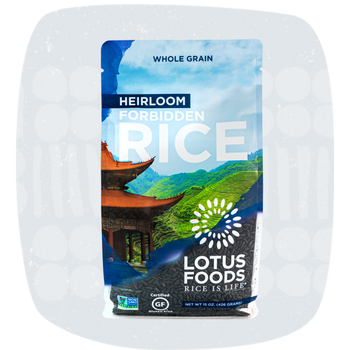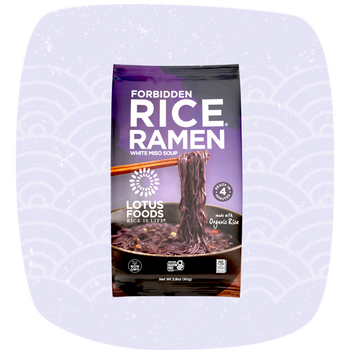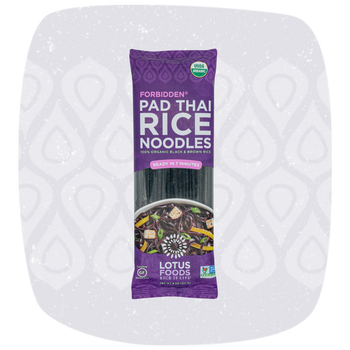Forbidden® Rice – A Love Story
August 12, 2020
There would be no Lotus Foods without Forbidden® Rice and no Forbidden Rice without Lotus Foods. Starting out as a young entrepreneurial couple, Caryl Levine and Ken Lee knew they wanted to start a business together, but what?
During a market research trip through China in 1993, they sat down in a village restaurant and were served steaming bowls of black rice. The flavor was so delicious – a roasted, nutty taste with hints of fruit – and the color of the rice was so dramatic. They were hooked. When they went to the market to buy some, they learned that black rice is called hei mei in Chinese, but is also referred to as ‘longevity rice’ or ‘tribute rice’, because according to legend in the Sung and Tang Dynasties (about 900 CE) it was reserved for the emperors to ensure their good health and long life. Imagine, it’s been cultivated for millennia! In traditional Chinese medicine, black rice is thought to be a blood tonifier, supporting a person’s qi, or life force, by restoring the body’s balance and harmony.
Shortly after, while touring the imperial Forbidden City, Ken had a sudden inspiration, “We could call the rice Forbidden Rice,” he told Caryl excitedly, “and market it as the Emperor’s Exclusive Grain!” Which they did! They trademarked the name “Forbidden Rice” in 1995 and shortly after ordered their first shipment of black Forbidden® Rice, starting on their 25-year journey of transforming how Americans think about and eat rice.
Lotus Foods trademarked the name “Forbidden Rice®” in 1995!
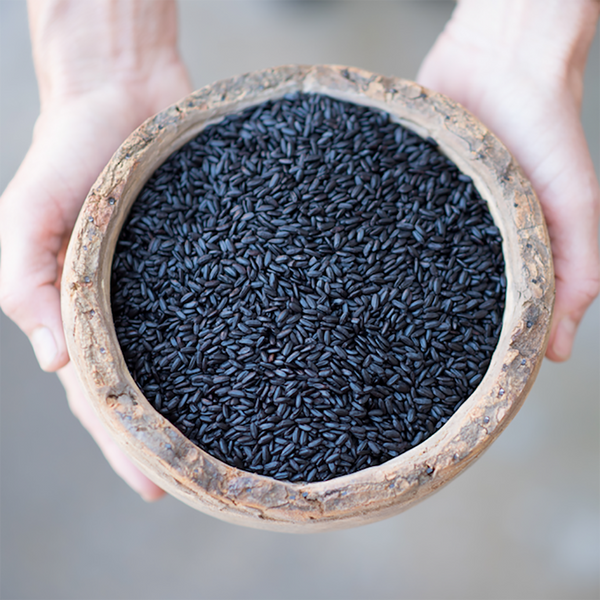
Flashback to 1995. At that time the landscape of rice in the U.S. looked like this:
· Commodity rice – long grain and short grain.
· Minute or instant rice.
· The most exotic imports were white basmati and jasmine rice.
· Brown rice was for hippies and people following a macrobiotic diet.
So how does one introduce an entirely unknown product into such a market? Americans are not traditionally rice eaters, and at the time most tended to see rice as a starchy side dish, almost like white Wonder Bread. Lotus Foods’ first customers were chefs in the San Francisco Bay Area. Chefs who, just like today, are at the frontlines in experimenting with new ingredients, innovating new flavor combinations, and breaking barriers.
What won them over first and foremost was taste, but then also the velvety texture and exotic purple-black plate presentation. Instead of being relegated to a side dish role, this delicious and eye-catching grain could star as a center-of-the-plate ingredient. Forbidden® Rice is now featured on the menus of restaurants across North America and sold at thousands of retail stores. Some restaurants you might recognize that have featured Forbidden® Rice include:
Bonefish Restaurants, California Pizza Kitchen, Restaurant Gary Danko, La Folie (Chef Roland Passot) and Gather Restaurant. It’s also included as an ingredient in foods prepared by Kika Sushi (prepared foods at Whole Foods Market), Amy’s Kitchen, Luvo, Hillary’s Eat Well, Theo Chocolate, Urban Remedy and Zego, among others. It’s also a growing favorite in boutique beers and sake.
Uniqueness of Forbidden Rice®
Lotus Foods’ Forbidden® Rice from China is unique in appearance and taste from other black rice varietals cultivated in Asia. It is a medium grain, has a solid jet-black color and nutty flavor. We have been sourcing rice throughout Asia for 25 years and while we have found black rice in Thailand, Vietnam, Indonesia, and India, they are always different, perhaps a longer grain or more glutinous. Ken and Caryl, as well as thousands of consumers, have preferred the black rice from China over these other varietals. Forbidden® Rice is a traditional local landrace that is cultivated in Northeast China, under conditions that are difficult to duplicate elsewhere due to the combination of soil type, water, temperatures, and day length, all of which influence its taste and nutrient profile. These attributes encompass the word terroir to describe a varietal’s unique sense of place.
Specifically, the rice is produced in China’s sub-arctic, unspoiled Heilongjiang Province at the limit of where rice can be grown; it is a long-season, cold-tolerant variety, very different from most black rice that is grown in tropical regions. Heilongjiang means Black Dragon River, which is the Chinese name for the River Amur. The region is famous for its humus-rich, highly fertile black soils and has become China’s organic grain basket. High soil fertility enhances yields without the need for synthetic fertilizer and low temperatures serve as a natural pesticide, reducing the possibility for the rice to be infected with diseases, thereby facilitating organic production.
The rice is grown in small batches on family-owned farms and not on a large commercial scale. The families from whom we source the rice rely on higher price premiums from Lotus Foods for their income.
Forbidden® Rice is grown in small batches on family-owned farms. The families we source the rice from rely on higher price premiums from Lotus Foods for their income.

Health Benefits
Throughout Asia, black rice is cherished as something special and valuable. It is largely reserved for ceremonies and rituals. There is now a growing body of research that reveals why this rice has been so prized through history, why the Emperors wanted to hoard it for themselves, and why we should all integrate it in our diets.
All whole grains contain what are called phytochemicals. These are bioactive non-nutrient plant compounds. Their vital functions include scavenging free radicals, antioxidant activity, enhancement of immune systems, and reduction of the risk of developing cancer and heart disease. In rice, these phytochemicals are concentrated in the bran. Unfortunately, they are usually removed in milling, drastically diminishing the health value of polished (white) rice. This is why we always encourage consumers to eat whole grain rice where possible.
In a comprehensive study of phytochemical profiles and antioxidant activity of black rice bran, Dr. Liu at Cornell University concluded that “black rice bran has a higher content of phenolics, flavonoids, and anthocyanins and has higher antioxidant activity when compared to white rice bran.” Anthocyanins are potent antioxidants that give the rice its black color; the same antioxidant that gives acai berries and blueberries their vivid color and potent health benefits. According to Zhimin Xu, an associate professor at Louisiana State University Agricultural Center, a spoonful of black rice bran contains the same amount of antioxidants found in a spoonful of blueberries, but with less sugar.
Some years ago, Lotus Foods donated black Forbidden® Rice and Bhutanese Red Rice to researchers at the University of Arkansas (UA), Fayetteville for a series of experiments they wanted to undertake. The outcome of one line of the study showed that black and red rice can “lower serum triglyceride levels and prevent hepatomegaly [enlarged liver] and thereby, possibly reducing the risk of CVD [cardiovascular disease].” We hope that this growing body of research will result in more clinical studies to guide consumers and health professionals.
Preserving Rice Biodiversity
Lotus Foods’ success with Forbidden® Rice and its pigmented Red Rice has not only motivated more research in the U.S. on the benefits of pigmented rice, but has also helped to fuel a renaissance in appreciation for heritage rices around the world. “When we started sourcing rice from Heilongjiang Province,” Caryl remembers, “the number of farmers still growing black rice was rapidly dwindling.”
Like everywhere throughout Asia, modern high-yielding rice varieties were pushing heirloom varieties out of production. And standardized milling equipment to process the modern varieties couldn’t handle rices of irregular shapes and sizes. Lotus Foods helped drive a steady and growing demand for organic black rice, ensuring the continued production of this exceptional heirloom grain. And as consumer acceptance of pigmented rice in the US increased, this stimulated a shift in consumer trends in other countries, like India, Indonesia, the Philippines and Thailand, to reconsider the value and benefits of their pigmented heritage varieties.
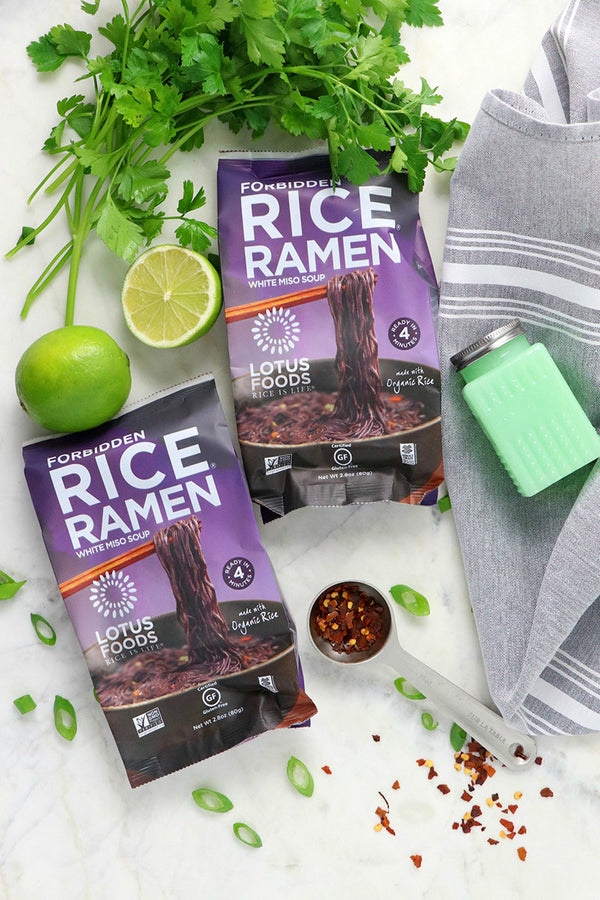
Forbidden Rice® Ramen noodles have a delicious nutty taste and are a natural source of antioxidants (anthocyanins), magnesium, protein, and fiber.
In 2012, when Lotus Foods began considering developing value-added products, we saw this as another way to support more farmers with higher price premiums and help promote organic production of black rice. So we proposed to our business partners in China the novel idea of using Forbidden® Rice in rice-based Ramen and Pad Thai noodles. This would give the noodles a nutritional and flavor boost, and a lovely dark purple color. Our quick-cooking organic Forbidden Rice® noodles have become extremely popular, with many customers using them as gluten-free pasta substitutes. Convenience has been a major driver. Who could have imagined that a simple bowl of black rice porridge would lead to so many amazing outcomes: healthier and more delicious rice for consumers; insightful research; more preservation of rice biodiversity; and thousands of farmers with improved livelihoods moving from conventional to organic rice production.
Resources
Women's Essential Role in Rice
The Benefits of Pigmented Rice



